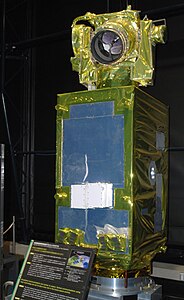cosmos.wikisort.org - Raumschiff
Kirari (japanisch きらり für Glitzern), auch OICETS (Optical Inter-orbit communications engineering test satellite) genannt, ist ein 570 kg schwerer japanischer Technologieerprobungssatellit für optische Datenübertragung (Laser Communication Terminal), den eine Dnepr-Trägerrakete am 23. August 2005 von Baikonur aus auf eine erdnahe Umlaufbahn von ca. 600 km Höhe brachte.
| Kirari | |
|---|---|
 | |
| Typ: | Technologieerprobungssatellit |
| Land: | |
| Betreiber: | |
| COSPAR-ID: | 2005-031A |
| Missionsdaten | |
| Masse: | 570 kg |
| Start: | 23. August 2005, 21:10 UTC |
| Startplatz: | Baikonur 109/95 |
| Trägerrakete: | Dnepr |
| Status: | außer Betrieb seit 24. September 2009 |
| Bahndaten[1] | |
| Umlaufzeit: | 96,8 min |
| Bahnneigung: | 97,8° |
| Apogäumshöhe: | 614 km |
| Perigäumshöhe: | 596 km |
Über Laser tauschte er im nahen Infrarotbereich (800 nm Wellenlänge) mit dem ca. 40.000 km entfernten Satelliten Artemis Daten aus. Ebenso konnte er ihn konventionell über Funk auf dem S-Band ansprechen. Am 7. Juni 2006 gelang auch eine optische Kommunikation mit einer mobilen Bodenstation des DLR in Oberpfaffenhofen.[2]
Die Mission war ursprünglich für ein Jahr geplant, aber Kirari arbeitete vier Jahre lang, bis er am 24. September 2009 abgeschaltet wurde.[3]
Weblinks
- JAXA: Optical Inter-orbit Communications Engineering Test Satellite (OICETS) (Memento vom 8. Dezember 2006 im Internet Archive) (englisch)
- Gunter's Space Page: OICETS (Kirari) (englisch)
Einzelnachweise
- Kirari in der Encyclopedia Astronautica, abgerufen am 17. August 2012 (englisch).
- Success with Optical Communication Experiment between the Optical Inter-orbit Communication Engineering Test Satellite "Kirari" (OICETS) and the Optical Ground Station at German Aerospace Center (DLR). (Nicht mehr online verfügbar.) JAXA, 9. Juni 2006, archiviert vom Original am 19. August 2011; abgerufen am 17. August 2012 (englisch). Info: Der Archivlink wurde automatisch eingesetzt und noch nicht geprüft. Bitte prüfe Original- und Archivlink gemäß Anleitung und entferne dann diesen Hinweis.
- KIRARI: Signals stopped; successful operation ends. JAXA, 24. September 2009, abgerufen am 17. August 2012 (englisch).
На других языках
- [de] Kirari
[en] OICETS
The Optical Inter-orbit Communications Engineering Test Satellite (OICETS), also called Kirari, was an experimental satellite launched by JAXA to demonstrate interorbital communication between satellites through optical (laser) means. OICETS was originally slated for a launch on the second J-I launcher. Due to problems with that launcher, the launch had to be put on hold. Using the H-IIA was out of question: it would have been overkill to use the H-IIA to send a 570 kilograms (1,260 lb) satellite into low Earth orbit, and there was no budget for another H-IIA launch. Finally, in order to be able to perform the tests during the lifetime of the European Artemis satellite (since 2014, sold to Avanti Communications to exploit its Ka, S, and L-band payloads), OICETS was successfully launched on an SS-18-based Dnepr rocket.[es] OICETS
OICETS (Optical Inter-orbit Communications Engineering Test Satellite), también denominado Kirari, es un satélite de comunicaciones experimental japonés lanzado el 23 de agosto de 2005 mediante un cohete Dnepr desde el cosmódromo de Baikonur.Другой контент может иметь иную лицензию. Перед использованием материалов сайта WikiSort.org внимательно изучите правила лицензирования конкретных элементов наполнения сайта.
WikiSort.org - проект по пересортировке и дополнению контента Википедии